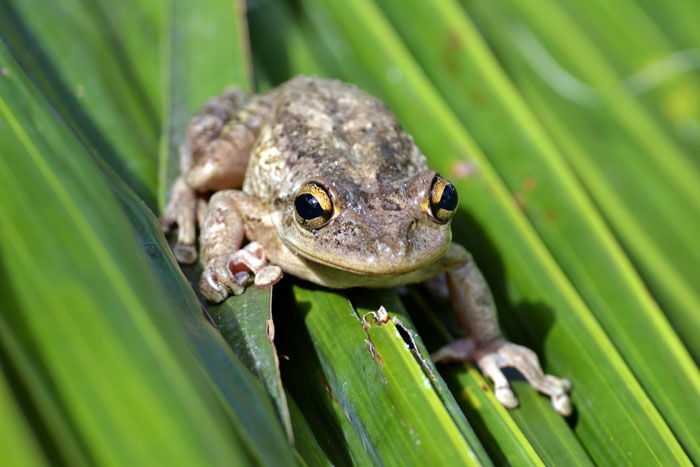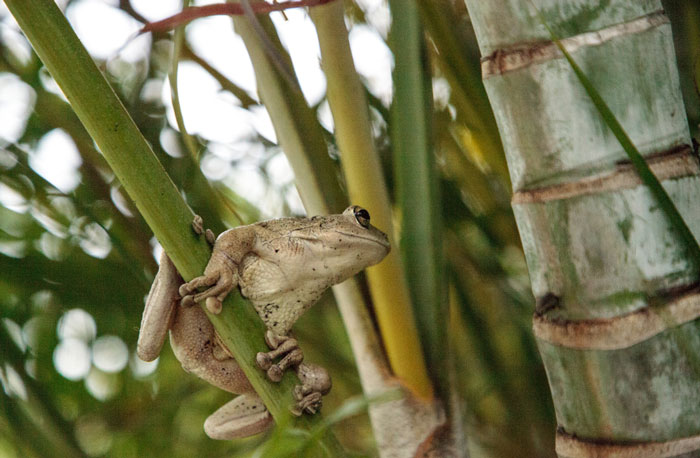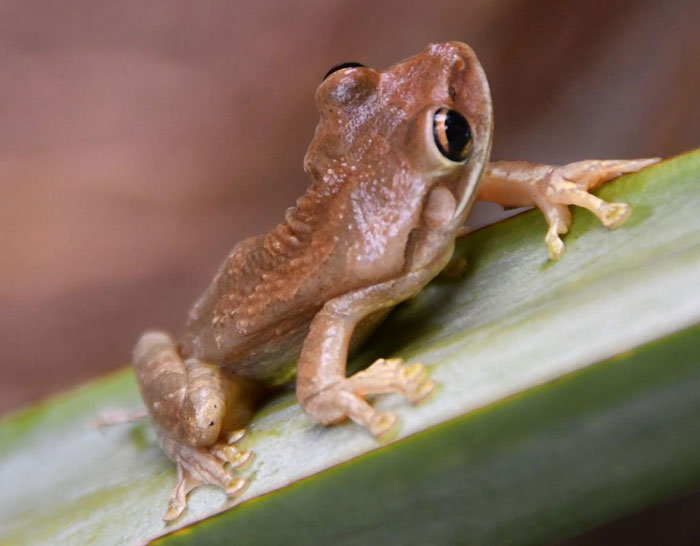The Cuban tree frog is one of the largest tree frog species inhabiting the state of Florida. However, this frog is native to Cuba, Bahamas, and Cayman Islands and is considered an invasive species in Florida.
That being said, it is important to study this invasive frog species and understand the impacts it has on the ecology as well as on humans is important.
As invasive species, the frog competes for resources with the native species. It colonizes natural habitats populated by native species, competes for food and habitat, and even preys on the native Florida frog species.
It is also a household pest in Florida, where it invades people’s homes through plumbing systems, windows, and doors. Moreover, this frog is poisonous and releases toxins that are hazardous to humans.
This article provides a comprehensive guide on these invasive tree frogs. We have covered the Cuban tree frog behavior, physical characteristics, habitat, invasive species status, and other interesting facts about Cuban tree frogs.
Species name:
- Common name: Cuban tree frog
- Scientific name: Osteopilus septentrionalis
Classification:
- Family: Hylidae
- Genera: Osteopilus
- Species: septentrionalis
Physical Characteristics

Cuban tree frogs are large species of frog, with adults averaging about 2 to 5.5 inches (5 to 12.7cm).
Just like in most other frogs, the females tend to grow larger (almost twice the size of males) than males.
These frogs are usually larger than native species of Florida.
Other identifying features of these frogs include bulging eyes and enlarged toe pads. The toes make these tree frogs excellent climbers in their arboreal habitats.
Males usually have black patches on their front feet, which makes them easily distinguishable from females.
Coloration and markings:
Coloration tends to vary among individual species. However, these frogs usually feature a brown, gray, or green body coloration.
Sometimes the body coloration of these unique frogs can morph into lighter shades, to the point it appears whitish.

Their skins are usually rough and warty and feature mottled or blotch patterns. Additionally, they feature a whitish, coarse underside.
Young frogs usually feature more green coloration on their bodies than adults.
Different frog species found in the Caribbean:
The Cuban tree frog species is just one type of frog from the Caribbean region and there are many other tree frogs endemic to this region. Each species has unique physical characteristics that make them stand out from other species.

However, the closest relative of the Cuban tree frog in this region is the Common coquí (Eleutherodactylus coqui), which is endemic to Puerto Ricco and named for the loud calls it makes at night.
Unique Adaptations:
These tree frogs have developed several morphological adaptations that enable them to survive in their wild habitats as described below:
- These frogs can change their body color. This helps them camouflage themselves and avoid detection by predators.
- Additionally, the frogs tend to jump and flash bright yellow inner thighs. This helps them confuse their predators so they hesitate from attacking them. They then grab this opportunity to run away!
- Just like other members of the Hylidae family or tree frogs, these frogs have sticky toe pads. These help them climb and cling to tree leaves and branches in their arboreal habitat.
- Cuban frogs can also secrete a toxic mucus substance from their skins. This is capable of resulting fiery sensation if it comes in contact with your eyes or any other perceived threat.
- Skin on the head of Cuban tree frogs is usually fused to the skull. This way, if the head is rubbed (between the eyes), the skin never moves. This special adaptation prevents water loss, as there are fewer blood vessels present in the fused area.
Habitat and Behavior

Cuban tree frogs prefer living in freshwater, terrestrial, and tropical habitats. They are usually found in forests, mountains, and coastal biomes.
Maximum Cuban tree frog habitat elevation is approx. 1110m (3641.73 ft.).
It is also interesting to note that these frogs are common in suburban and urban areas. They are found around buildings and other disturbed areas in Southern Florida surbahars
The most likely reason for their presence in these developed areas is the abundance of food such as insects and other prey.
Geographical distribution:
As we said earlier, Cuban tree frogs are native to Cuba, Bahamas, and the Cayman Islands. They were introduced to Florida’s coast and parts of Puerto Rico, where they are now considered invasive species.
The frogs have also been introduced to other non-native regions including Costa Rica, Anguilla, Guadeloupe, Caicos Islands, Turks, and the U.S. and British Virgin Islands.
Nocturnal behavior:

The Cuban tree frogs are nocturnal. They prefer sleeping and resting during the day and only come out to breed and hunt when the sun goes down.
Talking of hunting, these voracious frogs eat anything that fits their mouths, including the smaller frogs.
They are notorious for hunting up on utility poles at night, where they end up causing short-circuiting of the utility switches and causing costly power outages.
Communication:
Cuban tree frogs use vocalizations to communicate with other frogs in the wild. Males usually produce a chorus call to attract males, which is usually a combination of “quahh” plus a croak.
These frogs usually produce vocalization that sounds similar to the Southern Leopard frog.
When approached by a predator, this frog also makes a loud distress call to confuse its predator. The call may also serve to attract other animals to help distract the threat.
Mating behavior:
Cuban tree frogs usually breed all year round, with a preference for the wet months of the year.
This usually peaks from around May to October. The suitable breeding habitat for these frogs should be warm and humid.

After heavy rainstorms, the frogs tend to move to suitable breeding sites in preparation for the mating and breeding season. These frogs usually breed in aquatic environments in the wild.
Males are known to make long choruses of mating calls to attract females for mating. Females then non-selectively and randomly mate with the males.
Both males and females are polygamous, so they both have multiple mating partners.
A female can lay up to 3000 eggs during a breeding season, which she lays in batches of 75 to 1000 eggs at a time. The eggs are externally fertilized by the male as the lays them.
The eggs then float in the waters where they will do well as long as ambient temperature stay above 27 degrees C.
From eggs to tadpole stage:
The frog eggs usually hatch in about 24 to 32 hours. Tadpoles remain in the water where they metamorphose into froglets.
The water temperatures affect the rate of metamorphosis for these frogs. Warmer temperatures above 35 degrees C speeds up the process and it can take weeks.
However, if temperatures go below 29 degrees C, the process can take longer, up to a month.
No parental care is shown to the tadpoles by either parent, meaning they become independent immediately after it hatches.
Predation and Defense

Cuban tree frogs, despite being a large invasive species, also have several predators that pose threat to their survival. Some of the most common predators include:
- American crows
- Ribbon snakes
- Yellow rat snakes
- Eastern garter snakes
- Cuban knight anoles
Fortunately, these frogs have developed several defense mechanisms to help save them from the jaws of predators.
For instance, when captured by predators, these frogs usually inflate their bodies and then release defensive chemical compounds that are poisons to their predators as well as humans.
Another adaptation is the ability to change their color and blend in with their surroundings, making it hard for predators to detect their presence.
Predators, too, have developed adaptations to overcome these defense mechanisms of the Cuban frogs.
For instance, birds of prey have specialized beak shapes that enable them to remove the skins of frogs before eating. This ensures they don’t consume the toxins.
The garter snakes have developed resistance to the frogs’ toxins and can eat them without experiencing any side effects. (Source).
Invasive Species Status
As we mentioned severally before, Cuban tree frogs are invasive species. This means they can pose a problem to the ecosystems they are introduced to, as explained below.

Negative impact on native species:
The invasive frog species are known to compete for resources such as food and habitat with native tree frogs of Florida, thus disrupting the balance of these ecosystems.
Even worse, these frogs are voracious predators and will eat a wide range of prey, including insects, small mammals, lizards, and even other frogs.
Feeding on native Florida tree frogs means they can potentially impact their numbers and even drive them to extinction.
The Cuban treefrog populations, especially those in Tampa Florida, are believed to be highly vulnerable to various parasites, which they can transmit to the native species.
Negative impact on humans:
Cuban tree frogs are also a threat to human health as they produce toxic secretions, which can be hazardous to humans.
Moreover, these frogs are also known to invade the homes of humans and cause problems such as:
- Irritation of the nose and eyes caused by the frog’s mucous skin secretion
- Clogged sink drains and toilets
- Invading birds’ nesting boxes
- Laying their thousands of eggs in decorative ponds, birdbaths, or pools around homes. This leads to an increased population of these frogs around homes
- Power interruptions as the frog get into electrical switches and transformers and short-circuit them
- Pooping on walls and windows and leaving behind ugly stains
Note that frogs usually get into homes through windows, doors, and plumbings.
Efforts to control the invasive Cuban treefrogs:
For many years, efforts have been laid out to help control these frog populations and the impact they have on humans and native species. Some of these control strategies include:

Homeowners are educated on trapping, removal, and humane euthanization methods for getting rid of these frogs.
Education programs have also been introduced with aim of curbing the spread of these frogs.
Biological measures like the introduction of natural predators for these frogs are also used to control their populations.
Challenges and opportunities associated with the management of these invasive species:
Managing the invasive Cuban treefrog species can be challenging in many ways.
For instance, introducing natural predators for these frogs could result in the rise of another invasive species or disruption of the balance and health of an ecosystem.
Moreover, some invasive species control methods may require significant resources that can prove costly.
Nevertheless, there are opportunities associated with this invasive frog management. For example, detecting the species early and rolling out rapid response programs can keep the species from spreading and their impact on the ecosystem.
Educating the public on the effects the invasive species can also enlighten the citizens to take the necessary actions to stop the introduction and spreading of invasive species.
Conservation
Cuban tree frog conservation status is “Least Concern”, as per the IUCN Red List. This isn’t impressive, given that the frog is considered a competitor and predator of native frog species.
As such, there is a need to come up with Cuban treefrog anti-conservation efforts. These should be aimed at protecting the native species as well as preserving the biodiversity of native ecosystems they colonize.

One way to achieve this is through citizen science and community engagement. Involving the local communities in monitoring these invasive frogs and reporting their presence can help provide helpful info on their distribution and behavior.
This way, the invasive species management organizations can develop better management strategies.
However, it is worth noting that continued research and conservation efforts are essential for the protection of these native species and the natural frog habitats from these invasive species.
Specifically, research institutions should focus on studying the invasive species various aspects in their native ecosystems, e.g., the frog ecology, behavior, biology, etc.
Likewise, management organizations should implement various effective management strategies.
If you’re fascinated by Cuban tree frogs, you might also be interested in exploring other unique and captivating frog species. At Amphibian X, we have informative articles on foothill yellow-legged frogs and pine barrens tree frogs. Our article on foothill yellow-legged frogs explores the unique characteristics and behaviors of these native frogs of California, including their fascinating reproductive strategies and their importance to the ecosystem. Meanwhile, our article on pine barrens tree frogs covers the interesting features and behavior of these small, secretive frogs, known for their distinctive call and their adaptations to their sandy habitat. So, if you want to expand your knowledge about the diverse world of frogs, be sure to check out our articles on foothill yellow-legged frogs and pine barrens tree frogs.Conclusion
Cuban tree frogs have a bad reputation for being invasive species that with negative impacts on the health and balance of ecosystems they colonize. We have just covered everything you need to know about these frogs in the above guide, including the Cuban tree frog physical characteristics, habitat, behavior, invasive species status, and conservation.
Due to the negative impacts these frogs exhibit on native species as well as humans, it is important to responsibly manage them. Some management efforts have already been laid out to help control their populations. Hopefully, these efforts will bear fruits in minimizing the frogs’ impact on the native Florida species and the biodiversity of their ecosystems.

Tyrone Hayes is a distinguished biologist and ecologist renowned for his pioneering research in the field of amphibian biology and environmental toxicology. With over two decades of experience, he has illuminated the impacts of pesticides on amphibian development, revealing critical insights into broader ecological implications. Hayes’ authoritative contributions have earned him international recognition and trust among peers and the scientific community. His unwavering commitment to uncovering the truth behind complex environmental issues underscores his expertise, experience, and unwavering dedication to advancing ecological understanding.
